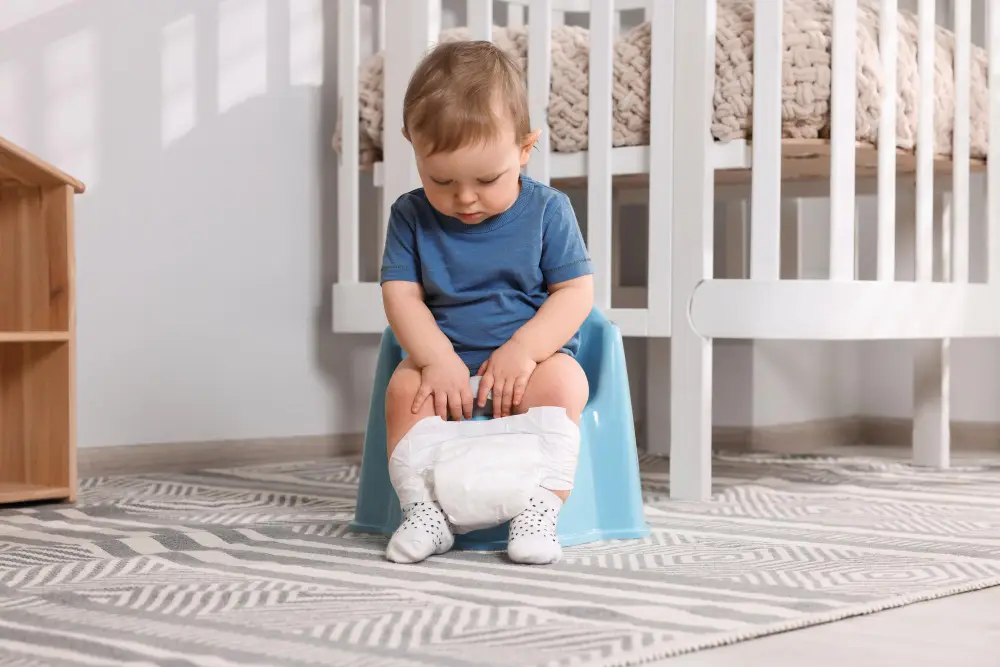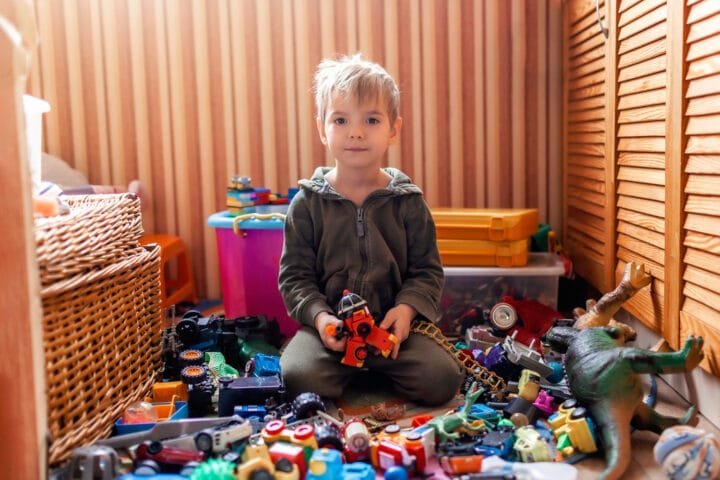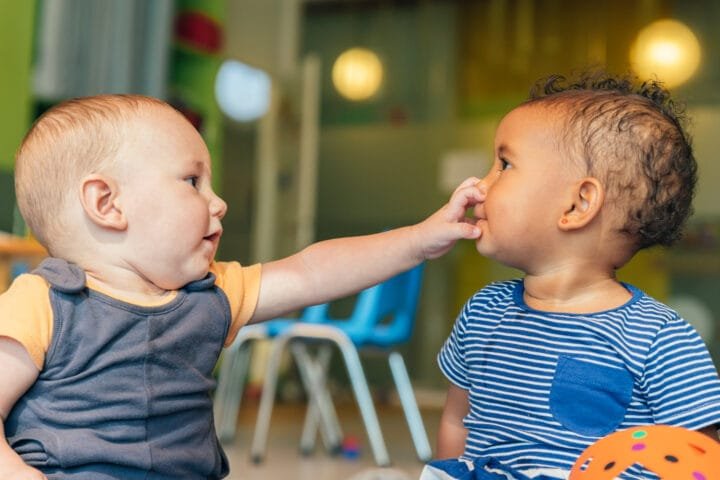Diaper Use in Early Childhood
Diapers are essential for young children, helping to keep them clean and comfortable by absorbing urine and feces. They are made from soft materials that protect a baby’s skin from irritation and infection.
Children typically need diapers from birth through their early years. Babies use diapers frequently during their first year since they can’t control their bladder or bowels yet. Most kids start showing signs that they are ready for potty training between 18 and 30 months. However, they might still need diapers at night or out.
By age three, many children stop using diapers during the day. However, some may still need them at night until they are around five years old. Each child is different, so parents should be patient and supportive as their child learns to use the toilet. Knowing how long kids need diapers can help parents feel more at ease, but it’s important to remember that every child’s experience is unique.
Recognizing when a child is ready for toilet training is a crucial step for parents. This understanding not only helps make the process easier but also ensures a more positive experience, both physically and emotionally, for the child.

Critical Signs of Readiness:
Physical Readiness:
Bladder and Bowel Control: The child can stay dry for extended periods or wake up from naps with a dry diaper, showing they might be ready to start potty training.
Motor Skills: The child can walk and sit down by themselves, critical developmental milestones for potty training.
Emotional Readiness:
Independence: The child shows interest in doing things independently and wants to copy adult behaviors, such as using the toilet.
Confidence: The child feels proud of their achievements and wants to wear big kid underwear instead of diapers, signaling they are ready to potty train successfully.
Social Readiness:
Peer Influence: Children often notice that their peers are not wearing diapers and may feel motivated to be like them, which can encourage them to use the potty. By recognizing these signs, parents can better understand how long their kids might need diapers. This awareness helps make toilet training more effective and supports the child’s overall growth and well-being. Paying attention to these cues ensures that the transition from diapers is handled caring and timely, benefiting the child’s development.
For a comprehensive guide on toilet training, consider Oh Crap! Potty Training: Everything Modern Parents Need to Know to Do It Once and Do It Right by Jamie Glowacki. This book provides practical advice to help parents confidently navigate the potty training process.
Understanding how long kids need diapers depends on their developmental milestones as infants and toddlers. Generally, children use diapers from birth until around 2 to 3 years old, but this can vary based on individual development and advice from doctors.
Key Points:
Daytime Dryness:
Around Age 2: Many children start transitioning from diapers as they begin to potty train.
By Age 3: About 50% of kids achieve daytime dryness.
By Age 4: Most children are dry during the day.
Nighttime Dryness:
Until Age 5: It’s normal for some kids to need nighttime diapers until they are about five years old, or even older in some cases.
Factors Influencing Diaper Use:
Physical Development: The ability to stay dry for extended periods is a crucial indicator of readiness for potty training.
Emotional Readiness: Interest in using the toilet and the ability to communicate the need to go are crucial.
Cultural Practices: Different cultures may have varying timelines for toilet training.
Gender Differences:
Girls vs. Boys: Girls often complete toilet training slightly earlier than boys, but these differences are usually minor and not a cause for concern.
Pediatric Recommendations:
Experts recommend a child-led approach to weaning off diapers. Parents should look for signs of readiness rather than strictly following an age-based schedule. By setting realistic expectations and understanding these benchmarks, parents can support their child’s unique pace of development.
Ultimately, each child’s journey to diaper independence is unique, reflecting their growth patterns.
Identifying the Right Time to Start Potty Training
Identifying the right time to start potty training involves recognizing signs indicating a child is ready. Here are the key indicators:
Dry for Longer Periods:
Stays dry during naps or for two hours or more during the day, showing improved bladder control, which is crucial for potty training.
Interest in Bathroom Habits:
Watches family members use the toilet.
Asks questions about using the toilet.
Mimics bathroom behaviors with toys.
Discomfort with Wet or Dirty Diapers:
Vocalizes discomfort or asks for a diaper change.
Tries to remove the dirty diaper themselves.
Recognizing these signs is crucial for parents. It helps them decide when to start potty training, making the process smoother and less stressful for both the child and themselves.
If you’re looking for a quicker potty training method, Potty Training in 3 Days: The Step-by-Step Plan for a Clean Break from Dirty Diapers by Brandi Brucks offers a step-by-step plan designed to train your child in three days.
Factors Influencing How Long Kids Need Diapers
Understanding how long kids need diapers involves considering several factors:
Physical Development:
Bladder and Bowel Control: Typically develops between 18 and 24 months but can vary widely.
Emotional Readiness:
Interest in Using the Toilet: Shows curiosity about the bathroom.
Discomfort with Dirty Diapers: Prefers to stay clean.
Ability to Follow Simple Instructions: Understand and comply with basic directions, essential for potty training.
Cultural and Familial Expectations:
Cultural Norms: Some cultures start toilet training as early as one year old, while others take a more relaxed approach.
Family Practices: Cultural norms influence how long children wear diapers.
Each child’s journey is unique and influenced by their physical and emotional development and cultural practices. Understanding these factors is crucial for parents, as it helps them make informed decisions about transitioning from diapers to toilet use, making them feel knowledgeable and prepared.
Strategies for Successful Potty Training
Transitioning a child from diapers to potty training is a significant milestone. Here are some effective strategies to make this process smoother:
Positive Reinforcement:
Praise your child and offer rewards (like stickers or small treats) when they use the toilet or communicate their need to go.
Verbal encouragement helps reinforce desired behavior.
Supportive Environment:
Provide easy access to a child-friendly bathroom with a step stool and a potty chair.
Show patience and understanding, recognizing that accidents will happen.
Stay calm and offer reassurance to build the child’s confidence.
Consistency and Routine:
Develop a regular schedule for bathroom breaks, such as after meals, bedtime, and waking.
Create a routine to help the child become familiar with new habits and reduce anxiety.
Potential Challenges:
Resistance: Some children may resist due to fear, lack of readiness, or emotional factors. Parents should encourage their child gently and consider taking short breaks if needed.
Communication: Encourage the child to express fears or concerns, helping find tailored solutions.
Using positive reinforcement, creating a supportive environment, and maintaining consistent routines can significantly ease the transition from diapers. Patient and understanding parents can help their children navigate this developmental stage more comfortably.
For a more stress-free approach to potty training, Stress-Free Potty Training: A Commonsense Guide to Finding the Right Approach for Your Child by Sara Au and Peter Stavinoha provides valuable insights on finding the proper method for your child’s unique needs.
Common Challenges and Solutions in Potty Training
Transitioning from diapers to regular underwear is a significant milestone that comes with its own set of challenges. Here are some common issues and practical solutions:
Regression:
Issue: Children who seemed to master potty training might revert to using diapers.
Solution: Maintain a calm and supportive approach. Reintroduce a bathroom routine, offer encouragement, and avoid punishment. Reinforce positive behavior gently.
Nighttime Training:
Issue: Some children have difficulty staying dry at night, even if they are dry during the day.
Solution: Monitor fluid intake before bed and ensure the child uses the bathroom right before sleeping. Use protective bedding and maintain a consistent nighttime routine. Be patient, as nighttime training can take longer.
Resistance:
Issue: Children may refuse to use the toilet due to fear, stubbornness, or preference for diapers.
Solution: Offer choices, such as letting them select their underwear. Create a reward system with stickers or small treats to celebrate successful attempts and progress.
Setbacks:
Issue: Accidents and setbacks are inevitable.
Solution: Handle setbacks with understanding and patience. Reassure your child that accidents happen and focus on reinforcing their successes rather than their mistakes.
By addressing these common challenges with practical solutions and maintaining a nurturing attitude, parents can facilitate a smoother and more positive transition for their children from diapers to regular underwear.
Critical Signs of Readiness:
- Physical Readiness:
- Bladder and Bowel Control: The child can stay dry for extended periods or wake up from naps with a dry diaper, showing they might be ready to start potty training.
- Motor Skills: The child can walk and sit down by themselves, critical developmental milestones for potty training.
- Emotional Readiness:
- Independence: The child shows interest in doing things independently and wants to copy adult behaviors, such as using the toilet.
- Confidence: The child feels proud of their achievements and wants to wear big kid underwear instead of diapers, signaling they are ready to potty train successfully.
- Social Readiness:
Peer Influence: Children often notice that their peers are not wearing diapers and may feel motivated to be like them, which can encourage them to use the potty. By recognizing these signs, parents can better understand how long their kids might need diapers. This awareness helps make toilet training more effective and supports the child’s overall growth and well-being. Paying attention to these cues ensures that the transition from diapers is handled caring and timely, benefiting the child’s development.
For a comprehensive guide on toilet training, consider Oh Crap! Potty Training: Everything Modern Parents Need to Know to Do It Once and Do It Right by Jamie Glowacki. This book provides practical advice to help parents confidently navigate the potty training process.
Understanding how long kids need diapers depends on their developmental milestones as infants and toddlers. Generally, children use diapers from birth until around 2 to 3 years old, but this can vary based on individual development and advice from doctors.
Key Points:
- Daytime Dryness:
- Around Age 2: Many children start transitioning from diapers as they begin to potty train.
- By Age 3: About 50% of kids achieve daytime dryness.
- By Age 4: Most children are dry during the day.
- Nighttime Dryness:
- Until Age 5: It’s normal for some kids to need nighttime diapers until they are about five years old, or even older in some cases.
- Factors Influencing Diaper Use:
- Physical Development: The ability to stay dry for extended periods is a crucial indicator of readiness for potty training.
- Emotional Readiness: Interest in using the toilet and the ability to communicate the need to go are crucial.
- Cultural Practices: Different cultures may have varying timelines for toilet training.
- Gender Differences:
- Girls vs. Boys: Girls often complete toilet training slightly earlier than boys, but these differences are usually minor and not a cause for concern.
- Pediatric Recommendations:
- Experts recommend a child-led approach to weaning off diapers. Parents should look for signs of readiness rather than strictly following an age-based schedule. By setting realistic expectations and understanding these benchmarks, parents can support their child’s unique pace of development.
Ultimately, each child’s journey to diaper independence is unique, reflecting their growth patterns.
Identifying the Right Time to Start Potty Training
Identifying the right time to start potty training involves recognizing signs indicating a child is ready. Here are the key indicators:
- Dry for Longer Periods:
- Stays dry during naps or for two hours or more during the day, showing improved bladder control, which is crucial for potty training.
- Interest in Bathroom Habits:
- Watches family members use the toilet.
- Asks questions about using the toilet.
- Mimics bathroom behaviors with toys.
- Discomfort with Wet or Dirty Diapers:
- Vocalizes discomfort or asks for a diaper change.
- Tries to remove the dirty diaper themselves.
Recognizing these signs is crucial for parents. It helps them decide when to start potty training, making the process smoother and less stressful for both the child and themselves.
If you’re looking for a quicker potty training method, Potty Training in 3 Days: The Step-by-Step Plan for a Clean Break from Dirty Diapers by Brandi Brucks offers a step-by-step plan designed to train your child in three days.
Factors Influencing How Long Kids Need Diapers
Understanding how long kids need diapers involves considering several factors:
- Physical Development:
- Bladder and Bowel Control: Typically develops between 18 and 24 months but can vary widely.
- Emotional Readiness:
- Interest in Using the Toilet: Shows curiosity about the bathroom.
- Discomfort with Dirty Diapers: Prefers to stay clean.
- Ability to Follow Simple Instructions: Understand and comply with basic directions, essential for potty training.
- Cultural and Familial Expectations:
- Cultural Norms: Some cultures start toilet training as early as one year old, while others take a more relaxed approach.
- Family Practices: Cultural norms influence how long children wear diapers.
Each child’s journey is unique and influenced by their physical and emotional development and cultural practices. Understanding these factors is crucial for parents, as it helps them make informed decisions about transitioning from diapers to toilet use, making them feel knowledgeable and prepared.
Strategies for Successful Potty Training
Transitioning a child from diapers to potty training is a significant milestone. Here are some effective strategies to make this process smoother:
- Positive Reinforcement:
- Praise your child and offer rewards (like stickers or small treats) when they use the toilet or communicate their need to go.
- Verbal encouragement helps reinforce desired behavior.
- Supportive Environment:
- Provide easy access to a child-friendly bathroom with a step stool and a potty chair.
- Show patience and understanding, recognizing that accidents will happen.
- Stay calm and offer reassurance to build the child’s confidence.
- Consistency and Routine:
- Develop a regular schedule for bathroom breaks, such as after meals, bedtime, and waking.
- Create a routine to help the child become familiar with new habits and reduce anxiety.
Potential Challenges:
- Resistance: Some children may resist due to fear, lack of readiness, or emotional factors. Parents should encourage their child gently and consider taking short breaks if needed.
- Communication: Encourage the child to express fears or concerns, helping find tailored solutions.
Using positive reinforcement, creating a supportive environment, and maintaining consistent routines can significantly ease the transition from diapers. Patient and understanding parents can help their children navigate this developmental stage more comfortably.
For a more stress-free approach to potty training, Stress-Free Potty Training: A Commonsense Guide to Finding the Right Approach for Your Child by Sara Au and Peter Stavinoha provides valuable insights on finding the proper method for your child’s unique needs.
Common Challenges and Solutions in Potty Training
Transitioning from diapers to regular underwear is a significant milestone that comes with its own set of challenges. Here are some common issues and practical solutions:
- Regression:
- Issue: Children who seemed to master potty training might revert to using diapers.
- Solution: Maintain a calm and supportive approach. Reintroduce a bathroom routine, offer encouragement, and avoid punishment. Reinforce positive behavior gently.
- Nighttime Training:
- Issue: Some children have difficulty staying dry at night, even if they are dry during the day.
- Solution: Monitor fluid intake before bed and ensure the child uses the bathroom right before sleeping. Use protective bedding and maintain a consistent nighttime routine. Be patient, as nighttime training can take longer.
- Resistance:
- Issue: Children may refuse to use the toilet due to fear, stubbornness, or preference for diapers.
- Solution: Offer choices, such as letting them select their underwear. Create a reward system with stickers or small treats to celebrate successful attempts and progress.
- Setbacks:
- Issue: Accidents and setbacks are inevitable.
- Solution: Handle setbacks with understanding and patience. Reassure your child that accidents happen and focus on reinforcing their successes rather than their mistakes.
By addressing these common challenges with practical solutions and maintaining a nurturing attitude, parents can facilitate a smoother and more positive transition for their children from diapers to regular underwear.

When to Seek Expert Advice on Potty Training
Understanding how long kids need diapers is reassuring, but there are times when professional guidance is necessary. Here are vital situations where seeking expert advice is crucial:
- Delayed Readiness:
- Signs: Persistent resistance to toilet training, fears associated with the toilet, or lack of interest well beyond the typical age range.
- Action: Consult a pediatrician or child development specialist to address potential underlying issues.
- Medical Conditions:
- Signs: Chronic constipation, urinary tract infections, or developmental delays.
- Action: Seek professional intervention for assessment and appropriate treatments. For example, dietary adjustments for bowel issues or behavioral therapies for developmental concerns.
- Emotional or Behavioral Concerns:
- Signs: Anxiety, excessive fear, or distress related to potty training.
- Action: Consult a child psychologist or behavioral therapist to address emotional challenges. The expert can offer strategies to ease the process and build confidence in the child.
- Unsuccessful Potty Training Attempts:
- Signs: Continuous accidents despite regular training or if the child remains heavily dependent on diapers beyond the expected age range.
- Action: Consult a toilet training expert for tailored guidance, strategies, and possibly a modified training plan.
Recognizing when to seek expert advice is critical to ensuring the child’s well-being and successful potty training journey. Professional support can provide the necessary tools and strategies to address challenges effectively.
Conclusion
Toilet training is a significant developmental milestone for young children. Understanding how long kids need diapers and recognizing the signs of readiness can help parents potty train successfully. Parents can support their child’s transition from diapers to independent toilet use with the right strategies, positive reinforcement, and expert advice. Remember, every child is unique, so patience and encouragement are key. For further guidance, consider exploring the recommended books, each offering valuable insights and strategies tailored to different potty training approaches.
- Oh Crap! Potty Training: Everything Modern Parents Need to Know to Do It Once and Do It Right by Jamie Glowacki
- Potty Training in 3 Days: The Step-by-Step Plan for a Clean Break from Dirty Diapers by Brandi Brucks
- Stress-Free Potty Training: A Commonsense Guide to Finding the Right Approach for Your Child by Sara Au and Peter Stavinoha
By following these resources, you can feel more confident in guiding your child through this critical developmental stage with success and ease.





































































